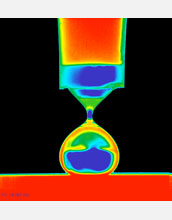Multimedia Gallery
Water Droplet On Superhydrophobic Surface (Image 1)
A color-enhanced image showing a droplet of water being deposited on a superhydrophobic (water-repelling) surface, just before it separates from the dropper used to deposit it.
A water hammer can occur when a valve is suddenly opened or closed in a pipe carrying water or steam, causing a pressure wave to travel down the pipe with enough force that it can sometimes cause the pipes to burst. Now, new research by MIT researcher Kripa Varanasi, the d'Arbeloff Assistant Professor of Mechanical Engineering, shows that a similar effect takes place on a tiny scale whenever a droplet of water strikes a surface.
The research was funded in part by a grant from the National Science Foundation (CBET 09-52564). To learn more, see the MIT news story "Research update: How to tame hammering droplets." (Date of Image: January 2011) [See related image Here.]
Credit: Kripa K. Varanasi, Massachusetts Institute of Technology
Images and other media in the National Science Foundation Multimedia Gallery are available for use in print and electronic material by NSF employees, members of the media, university staff, teachers and the general public. All media in the gallery are intended for personal, educational and nonprofit/non-commercial use only.
Images credited to the National Science Foundation, a federal agency, are in the public domain. The images were created by employees of the United States Government as part of their official duties or prepared by contractors as "works for hire" for NSF. You may freely use NSF-credited images and, at your discretion, credit NSF with a "Courtesy: National Science Foundation" notation.
Additional information about general usage can be found in Conditions.
Also Available:
Download the high-resolution TIF version of the image. (853 KB)
Use your mouse to right-click (Mac users may need to Ctrl-click) the link above and choose the option that will save the file or target to your computer.

